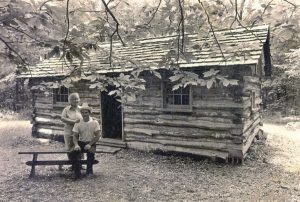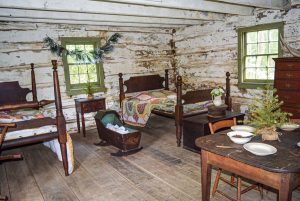Erma Ingram began a unique collection in the 1950s. While others gathered stamps or coins, Ingram, a resident of the Marion County village of Kinmundy, opted for something a little more substantial — log cabins. Not models or figurines, but actual log cabins.
Her collection not only preserves history but also delights and educates visitors to this day.
When she started, others were embracing the new technology and lifestyle of post-war America, but Ingram realized that the log cabins of the previous century were rapidly disappearing. She set out to do something about it. As plans for the development of the nearby Stephen A. Forbes State Park included the demolition of several cabins, Ingram began a one-woman mission.

Well, one woman, her son and his friends. In what might have been a Tom Sawyer-like effort, Erma’s son Bob convinced his classmates to help label and then dismantle a number of cabins before moving them to a 40-acre tract just north of Kinmundy, where they were painstakingly put back together, piece by piece.
Over the next two decades, Ingram’s collection grew to more than 10 cabins, most originating from within a day’s drive. She outfitted each one with antiques from her personal collection, giving a glimpse of prairie life in the early to mid-1800s. Whenever possible, Ingram gleaned as much history about the structures and the people who lived in them as she could.
Not content to keep her collection private, she would give the occasional tour of what came to be known as “Pioneer Log Cabin Village” and each fall would open the grounds to the public, artisans and vendors as part of what eventually became an annual fall craft show, complete with historical reenactors demonstrating and teaching pioneer ways.
After Erma died in 2003, her son continued to maintain the village until his own death in 2016. During Bob’s later years, members of the local historical society often would help with the upkeep of the cabins and with the annual fall festival, which was growing in popularity.
When he died, the property — per Erma’s wishes — was deeded to Shriners Hospitals for Children. To say that the nonprofit health care organization did not know what to do with the log cabins would be accurate. In fact, they were not even aware they owned it.
“When Bob passed away, the festival was already being planned; vendors were all lined up and had already paid,” explains Rick Hanks, a member of the historical society at the time. Hanks currently serves as president of Kinmundy Promotions, Inc. (KPI), a not-for-profit organization with the sole purpose of supporting the log cabin village.
“We got ahold of them to see if we could have the festival as planned, and they didn’t even know they had inherited everything,” Hanks recalls. “They said as long as we had the plans and the insurance, we could go ahead.”
Over the next few years, the sale of the property to that local entity was negotiated, and the organization continues to maintain the structures, improve the grounds and hold public events at what is now officially called Kinmundy Log Cabin Village.
Currently, the village consists of 12 period cabins, most originally erected within a few miles from where they now stand. A majority of the cabins are single room, but some include lean-to additions.


One structure, Jacob’s Well Stagecoach Inn, was originally located on the old Egyptian Trail, which ran from Rockford to Cairo, before the large cabin was dismantled and reassembled on the grounds. Upon reconstruction, only the lower floors were rebuilt; a third floor reachable only by an exterior ladder was not included. Legend has it that overnight guests at the inn included Abraham Lincoln and Jesse James.
“That would have been when [Lincoln] was a lawyer on the judicial circuit, but there’s nothing we have to prove that he ever stayed there,” Hanks admits.
Whenever possible, the history of the cabins has been preserved along with the structures themselves, but with some, little is known. One such building is the Stevenson Cabin, relocated to Kinmundy from south of Decatur. At Log Cabin Village, it has been repurposed as a church and one-room schoolhouse, outfitted with period-correct desks, slates, maps and other teaching tools. It is a primary stop for classes on school field trips to the village every spring. Students even get to summon their peers by ringing the bell.
Andy Waterman of Illinois South Tourism made his first visit to Kinmundy Log Cabin Village last fall. He was taken aback by the cabins, especially the school building.
“It’s off the beaten path, but it’s a really cool ‘off the beaten path,’” he says. “It’s like stepping back in time. I’m a history buff, and if it wasn’t for the sound of traffic from Interstate 57, I would have forgotten all about the modern world for a little while.”
He says visits to the village are educational.

“You really get to see how settlers lived, and it is eye-opening,” he says. “You look in the cabin and then realize that three or four people or even more all lived together in this tiny room. Even the beds looked so tight, you can’t believe how people would sleep in them. It is special and makes me appreciate how things are [now], because we don’t have to live like that anymore.”
Hanks explains that most of the cabins are true to 18th-century living.
“The village is a group of 12 historically correct cabins,” explains Julie Green, a local educator and volunteer with KPI. “Everything is authentic. Visitors can walk into the cabins and see that they are furnished with time-period-correct furniture. During our events, everything is open and visitor-friendly so people can come in, ask questions and learn from the volunteers.”
Green’s family first became involved with Log Cabin Village as reenactors dressing in period costumes.
“We’ve made homemade butter and shared samples; my husband has demonstrated blacksmithing and how to fire a black powder rifle,” she says.

The historical reenactors, like those who serve on the organization’s board, all are volunteers and showcase a wide variety of crafts and skills during the village’s two fairs held each fall. During these events, thousands of visitors walk through the grounds, not only visiting the cabins and watching demonstrations, but also sampling the foods and perusing the crafts and other vendor booths, nearly 150 in all, that line the wooded paths throughout the village.
Hanks explains, “Whenever we have our festivals, all the cabins are manned with people who dress in period costumes. At almost every cabin, someone is demonstrating a pioneer skill, sharing about the essential life skills of the time. We also want people to go into the cabins and not only look around, but to touch the silverware, the furniture, the spinning wheels; we want them to know what it was like actually living in those cabins at that time. It is all about the preservation of a simpler, harder time.”
Outside of field trips and arranged private tours, the fall festivals — always held during the final two weekends of September — give one of few opportunities for public access to the cabins. Proceeds from the two weekends are used for the upkeep of the cabins and grounds and fund several scholarships for students at nearby South Central High School.
“We totally operate on what we make from the fall events and donations,” Hanks explains, adding that in recent years, a secondary set of events has been added to the calendar. Two weekends of a “Haunted Trail” weave through the woods and cabins, giving thrills and chills to those brave enough to take part. More than 3,000 people participated in the 2022 Halloween-themed paths.
“Some of the younger ones in our group suggested the haunted trail, and I didn’t think it would go over at all,” Hanks shrugs. “But I can’t believe how many people pay to get scared. It’s really taken off. This was our fifth year.”
Local leaders appreciate the village not only for its preservation of history but for bringing people to the community of about 800 residents.
“The log cabin village really is a blast from the past,” Kinmundy Mayor Angie Diss says. “It’s an awesome place and a great way to remember that people used to live like that.”
The village is making a difference not only in educating people about a bygone era, but also by benefiting the area in other ways.
“I don’t know how you equate what we do to dollars, but I know that there is an economic impact with all of the vendors and guests coming to our community and the area,” Hanks says.
Mayor Diss agrees. “Log Cabin Village is an invaluable resource,” she says. “We get a lot of people who come through each year; it brings thousands of people to our community. It has become the thing that our community is known for.”
The village and its reputation both continue to grow. Volunteers recently poured footings for two more cabins being donated by local landowners to be rebuilt at the village — the first cabins assembled there since 1978.
“Erma had a vision,” Green says. “Who else would have thought all of this would still be here and people would still be coming to see it all these years later? She preserved history, and we’re going to continue that because they don’t make them like this anymore.”
Let’s GO!
Kinmundy Log Cabin Village is located at 6260 Gesell Road, north of Kinmundy. The fall festivals are held the last two weekends of September, and the Haunted Trail events are held the last two weekends of October. Visits are available by appointment only. Call 618-267-2227 or email kdylogcabin@gmail.com. For more details, go to kinmundylogcabinvillage.com.










